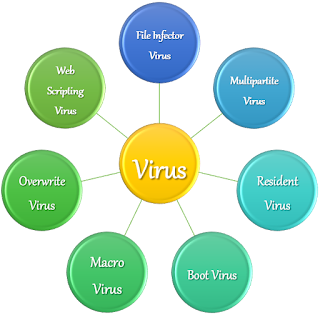Virus
- A virus is a computer code or program, which is capable of affecting your computer data badly by corrupting or destroying them.
- Computer virus has the tendency to make its duplicate copies at a swift pace, and also spread it across every folder and damage the data of your computer system.
- A computer virus is a malicious software program or "malware" which, when infecting your system, replicates itself by modifying other computer programs and inserting its own code.
 Types Of Virus :-
Types Of Virus :-
- File Infector Virus
- Multipartite Virus
- Resident Virus
- Boot Virus
- Macro Viruss
- Overwrite Virus
- Web Scripting Virus
Impact of Virus :-
- Disrupts the normal functionality of respective computer system.
- Disrupts system network use.
- Modifies configuration setting of the system.
- Destructs data.
- Disrupts computer network resources.
- Destructs of confidential data.
- Infected computer programs may include data files, or even the "boot" sector of the hard drive.
 Symptoms of infected System :-
Symptoms of infected System :-
- A very slow running computer
- Pop-up messages that appear out of nowhere and are hard to get rid off.
- Computer programs starting that you don’t recognize or didn’t start up yourself.
- You can hear the sound of the hard drive in constant action.
- Computer does not take command properly.
Preventive measures for System :-
- Remove Temprorary files
- Disk cleanup
- Disk defragments
- Installation of an effective antivirus software.
- Patching up the operating system.
- Patching up the client software.
- Putting highly secured Passwords.
- Use of Firewalls.
- Regular Windows Defender Scanning

Most Effective Antiviruses :-
- McAfee Antivirus Plus
- Symantec Norton Antivirus
- Avast Pro Antivirus
- Bit-defender Antivirus Plus
- Kaspersky Anti-Virus
- Avira Antivirus
- Webroot Secure Anywhere Antivirus
- Emsisoft Anti-Malware
- Quick Heal Antivirus
- ESET NOD32 Antivirus
- Microsoft Essential
- AVG AntiVirus FREE
- Microsoft Safety Scanner



Amazing and Creative blogs that you see.. Its latest version indormation......'
ReplyDeleteEpubor Ultimate eBook Converter crack
Evaer video recorder crack
Combo Cleaner Premium Crack
Aiseesoft Screen Recorder Crack
DVBViewer Crack
ApowerPDF Crack
Microsoft Safety Scanner Crack
Leawo Music Recorder Crack
Keyscape Mac Crack
FotoWorks XL Crack